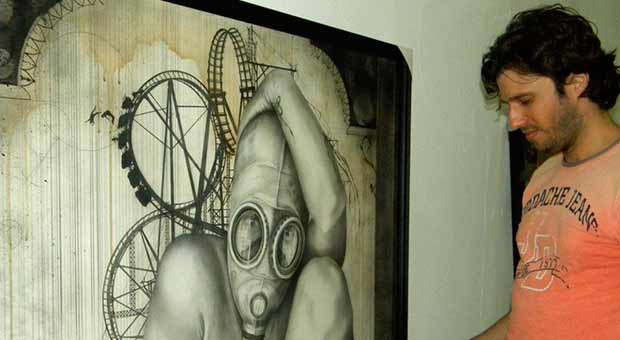With the title Diario del naufragio (Logbook of a shipwreck), young artist Frank Rodríguez Ventosa (F. Rodvent) exhibits a dozen pieces in different formats and techniques, which make up the main sample of the 13th edition of ICAIC’s Young Sample. Some of these pieces will become the awards to be presented to the winners of the event.
Films such as Conducta impropia, Recibido en mal estado and El elegido will be exhibited until April 21 at the Gallery of the Fresa y Chocolate Cultural Center.
Rodvent, who is an autodidact, is a member of the Hermanos Saiz Association (AHS by its acronym in Spanish) and stands out for his outstanding talent for drawing. In his work, he shows his personal vision of the world and the country where human beings and machines copulate, with diverse symbols and concepts.
By means of chiaroscuros and clean strokes, which eventually make us recall Fabelo, he portrays men and machines in constant symbiosis with an aesthetics that gets close to futurism and science fiction. Perhaps this has to do with the first book he had in his hands when he decided to become an artist: A Treatise On Painting. by Leonardo Da Vinci. Perhaps he inherited futuristic machines –which on this occasion are accompanied by different icons like the Cuban flag and recurrent naked women– from this great master.
“A female body always implies eroticism but that’s not the main purpose of this exhibit, this time it is an allusion to abandonment, what you see on the skin, what is exposed, from a more sensitive point of view conceptually speaking.” explained the artist to OnCuba.
The pieces work as some sort of collection of anecdotes of his own and of the people close to him. It is a logbook because it collects experiences and it is a shipwreck because it refers to insularity and the absurd circumstance of being surrounded by water everywhere.
As said by its author, this selection is about dreams and memories: “they are eleven drawings and a sculpture, which are a project for smelting entitled Estado de cuentas (state of affairs) which is my vision of what is going on nowadays”, Rodvent affirmed.
Cuba is immersed in a process of change; it is taking positive steps, which has a lot to do with what happened earlier. These pieces are connected with our reality, with our present but they make reference to history, to earlier events that gave way to what’s going on today.
By means of faded lines that get mixed upthere are pieces that portray religious images, though they have nothing to do with religion. It seems he uses them to give something of eternal truth impregnated by sacred elements. The artist also expresses the concerns of his generation and compatriot and tackles daily routine through contrasted ideologies, spiritual shortages, crisis of values and other conflicts of contemporary society.
“I used to sign by the name of Gallego, people used to call me that because I’m a Spanish descendant, then I started to join both names to identify myself so as to not confuse spectators about my nationality”, expressed the creator, who is a Catalandescendant and has exhibited his pieces repeatedly in Spain, France, and Havana, individually and collectively. Some of his work belongs to private collections in the United States, Mexico, Germany, England and Northern Ireland, among other countries.
This is not a colorful sample in which plastic values prevail. Black and whitedoesn’t exist in nature but they emerge in the exhibit that alludes to the past and the oneiric. “I don’t use colors because these evocations come to me without color, they are not clear, that’s why I also draw some stains as synonym of something unconcluded”, said this creator who walks away from the threshed tropical subject and the frequent topic s of the national plastic art to make up a Cuban and universal piece at the same time.
I have always believed ICAIC’s Young Sample and the interaction with other artists are very interesting. I presented the project of this exhibit almost two years ago and fortunately it was approved. I think that what brings us closer is the way to reflect something intimate, to express ourselves independently, freely and not to order, spontaneously. We also share the need to say something rather than to get recognition.










